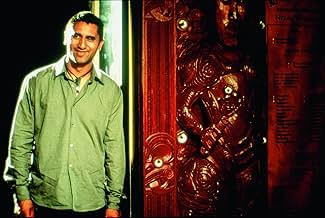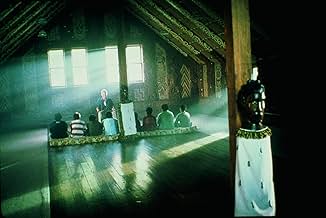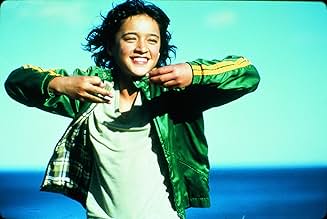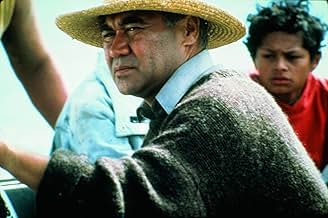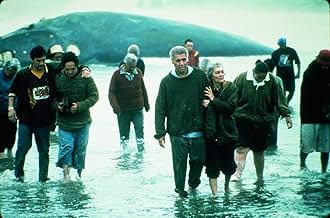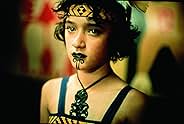Adicionar um enredo no seu idiomaA contemporary story of love, rejection and triumph as a young Maori girl fights to fulfill a destiny her grandfather refuses to recognize.A contemporary story of love, rejection and triumph as a young Maori girl fights to fulfill a destiny her grandfather refuses to recognize.A contemporary story of love, rejection and triumph as a young Maori girl fights to fulfill a destiny her grandfather refuses to recognize.
- Direção
- Roteiristas
- Artistas
- Indicado a 1 Oscar
- 33 vitórias e 35 indicações no total
- Maka
- (as Mabel Wharekawa-Burt)
- Hemi's Dad
- (as Roimata Taimana)
- Jake
- (as Tyrone White)
- Direção
- Roteiristas
- Elenco e equipe completos
- Produção, bilheteria e muito mais no IMDbPro
Avaliações em destaque
The strangers cast her as the lead in a film. Though it looked like a small film to begin with, it turned out to be an international blockbuster. Then one day, she read in the newspaper that she had been nominated for the most prestigious acting award in the entire world. Her first acting performance had catapulted her from obscurity to the winner's circle, in competition with Diane Keaton, Samantha Morton, Charlize Theron and Naomi Watts for Best Actress in a Leading Role.
Keisha Castle-Hughes is the youngest person ever to be nominated for best actress by the Academy of Motion Picture Arts and Sciences. Anna Paquin, discovered by the same casting agent, won an Oscar in 1993 for The Piano, but that was for Best Actress in a Supporting Role. Yet she was not the youngest. In 1973, Tatem O'Neal won for Paper Moon at the ripe old age of ten.
So, we have established that fairy tales can still come true, but not without the proper vehicle, and I do not mean a pumpkin drawn by white mice. The vehicle in this instance is a very carefully designed and orchestrated film. And where do great films start? With the writer(s), of course.
Another fairy tale? Witi Ihimaera is the first Maori writer ever to have published both a book of short stories and a novel. He says he was sitting in his New York home one day overlooking the Hudson River when he saw a whale breach the waterline. A whale in the Hudson River? Mr. Ihimaera took it as a sign.
Inspired by stories of ancient tradition that streamed into his mind, over the next three weeks, Mr. Ihimaera wrote The Whale Rider. It is this one work of his that the Maori community accepts as being most representative of their culture, and the novel that became the backbone for the screenplay for the film Whale Rider (co-written by Witi Ihimaera and director Niki Caro).
Maori legend tells of a great man, Paikea, who came many ages ago riding o n the back of a whale and landed on the shores of a new world. He left word that someday another great whale rider would be born to lead the Maori people.
The film begins with a scene in a hospital of a young woman giving birth to twins. The boy is stillborn. With her last breath, she whispers to her husband, `Paikea, Paikea.' The remaining girl child is blessed with that name as the mother dies.
Paikea's father, Porourangi (Cliff Curtis), crushed by the loss of his wife, departs his homeland, leaving Paikea in the caring hands of his parents, Koro and Nanny Flowers. `Pai' grows and becomes strong in the teachings of her people, yet she hears an inner voice as well.
Koro, her grandfather, is the chief of his people. When he sees that his son will not return, he begins to train the local boys in the ways of leadership. Pai believes that she could become the leader of her people, but her grandfather, though he loves her, rejects her.
Pai cannot be daunted; she is tougher than any of the boys. She hides around corners and eavesdrops as the boys are trained, learning the lessons, dance, movements and traditional ceremonies of her people.
Once he feels they are ready, Koro takes the boys out in a boat on the ocean and here he removes the carved whale's tooth, symbol of the chief, from around his neck, tossing it into the water. Though they try, none of the boys is able to retrieve it.
Here, the film takes a turn, one that is somewhat unexpected, and one that sets this film apart from the run of the mill. As part of a school pageant, Pai has written a work in honor of her people and has asked her grandfather to attend. It is this performance of the young woman that tests her skills as an actress, and is certainly one of the most touching moments in the film.
The rest of the film does not hinge so much on whether Pai's grandfather attends her performance or not. Something else occurs. Seven whales have beached themselves on the shore. Paikea has called the whales and they have responded to her call. As the people of the village struggle to help the whales return to the ocean before they die, Koro's other son shows him the carved whale's tooth.
`Which of the boys got it?' Koro asks. His son tells him it wasn't one of the boys. `It was she,' he says, pointing to Paikea, now sitting on the back of the biggest of the whales.
There is a very big difference in a film made for twelve-year-old girls and a film about a twelve-year-old girl, especially one on the threshold of womanhood. This is a film about traditions, about beliefs, about growing up, about magic, and about love.
Director Niki Caro transcends ordinary film making with Whale Rider. The film played to standing ovations at both the Toronto and Sundance film festivals, and with good reason. It is not a film that tells us anything is possible. It shows us. It does not sink into despair over the disappearing way of life of the Maori people. It shows us that any group of people, any tribe or village, any nation, can survive and even prosper if we rely on what we feel in our hearts.
The DVD of 'Whale Rider' was released in 2004 but it never attracted me greatly. and getting round to watching it has taken me some time. There are so many films of a similar type where the story sounds very admirable and wholesome, but experience warns that the combination of a cast of enthusiastic and largely non-professional actors, a limited budget, and over-enthusiastic direction by somebody not fully understanding the limitations of the medium, often culminates in a rather mawkish product. The fear that this might have happened here has kept me away for a long time. To anyone else in this position let me recommend getting a disk and giving it a spin as soon as possible.
Admittedly promoters of such films take a considerable risk - often their final budget stands or falls largely on the performance of the star. The rest of the cast are essentially ordinary people playing themselves and even though they may not have much acting experience, their parts are not too demanding so minor imperfections are often not too disruptive. But one minor glitch in the performance of the star can break the spell which is created when the audience begins to feel involved in the story and concerned about what happens to the individuals portrayed. This is essentially a film by a woman director about feminine empowerment, but not the sterile antagonistic type which looks for a world run exclusively by women (preferably with only a few men left around to keep the sperm banks well stocked). Here we are looking at the true equality that first began to be recognised during the World Wars of the twentieth century when everyone understood there was an enormous task to accomplish and we could never finish it unless we harnessed the full abilities of everyone in our society. This is a film from New Zealand where the leaders of a traditionally male dominated Maori culture, badly disrupted by the impact of the more sophisticated civilization of western settlers, are attempting to go back to their roots to avoid being totally absorbed into the new colonial culture but remain unable to fully recognise that women must play a vital part in any process of cultural regeneration. This film, based on a book by the first Maori author to have a work published in North America, is a fictional fable that shows one way in which such an essential change to the fundamental structure of their traditional culture might take place.
This may not sound like the basis for an enjoyable film for a Western family audience, but the host of best film awards it has received does convey some sense of the extent to which it is a very exceptional movie. Although almost everyone involved played their full part in its success; it was ultimately the outstanding Oscar nominated performance given by its star which made the film memorable. Keisha Castle-Hughes was 12 years old when this was filmed and it won her the youngest ever Best Actress nomination. If there were only more young actors of this calibre, we might have more films fostering positive values in society, rather than often competing to outdo each other in violence, horror or degradation. Incidentally, but more importantly, we might also begin to find that the former films are capable of providing us all, including the younger generation, with a generally more enjoyable viewing experience.
The story is a battle of wills between the tradition bound village elder Koro (solidly played by Rawiri Paratene) and his own grand-daughter Pai. Koro is seeking a new chief among the first-born sons of his village to inspire their tribe in its present day struggles in 21st century New Zealand. Pai senses in her heart that she is that new chief (despite her gender) and will not give up her quest to prove herself worthy of the task, even if she has to do her training surreptitiously outside of the eye of her beloved (but unbending) grandfather. This is all filmed in the actual Whangara tribal areas on the North Island east coast with the enthusiastic participation of the present day descendants of the original whale rider Paikea, who, as legend has it, was brought to shore on the back of a whale.
Although this film deals with a small corner of the planet, its values and inspiring messages are universal and should find a welcome audience everywhere. Everyone is already familiar with New Zealand as the location setting for Peter Jackson's epic trilogy of the Lord of the Rings and now they have a chance to discover something about the real people who live there and their heritage. Highly recommended. A 10 out of 10!
Then something happens as the film flashes forward 12 years. The girl "Pai" (pie), is discovering that her community needs her, and all the signs point that she must lead her people. There is only one problem. The chief must be a man.
It's at this point the film literally becomes a simple story, as a young girl goes about trying to convince her awful grandfather that she is to lead the village. Many obligatory scenes are set up, and we all see the pre-destination, but it is the transformation that the viewer witnesses that is so powerful, and a payoff that can only be described as awe-inspiring.
Incredibly touching, deeply moving, wonderfuly acted, and beautiful cinematography, it's not small surprise why this film is a winner. Pai is a complete scene stealer, and it's finally nice to see Cliff Curtis show off some true acting skills. For Cliff who has played everything from a tattoed Hispanic gang leader in Training Day, to a Arab villan in the Majestic, it's pleasing to see him in a character that mirror's his true national identity since he is actually a New Zealander and not a Hispanic or Arab person. He must be incredibly proud to be part of this special film. The actors who played the grand parents are exceptional particularly the stubborn grandfather who's demands Pai keep away from all male activities (The grandfather's insistence to teach a young group of boys in a special school how to be chiefs, and Pai's insistence to learn without her gradfather's knowledge provides most of the light humour in the film).
Amazing film easily one of the best of the year
Rating 9 out of 10.
The remarkably beautiful and serene scenery of New Zealand complements the eventual inner peace that Paikea achieves. To save the whales their tribe loves so much, she shows remarkable calmness in guiding the whales back into sea despite death staring her straight in the face.
An inspiring and well-executed film.
Você sabia?
- CuriosidadesThe whales in the movie are a combination of footage of real whales, life size models (some with humans creating movement) and CGI. Keisha Castle-Hughes said the key whale riding scene took place 15-20 miles offshore, and was terrifying.
- Erros de gravaçãoThe father and grandfather argue after the slide show, and the father goes to pull down the white sheet that was hung over some drapes to act as a screen. He pulls it down, along with the rod and orange drapes that the sheet was hanging from. Moments later, the drapes are back up in place and hanging perfectly straight, without enough time for him to re-hang the drapes.
- Citações
[first lines]
Paikea: In the old days, the land felt a great emptiness. It was waiting. Waiting to be filled up. Waiting for someone to love it. Waiting for a leader.
[child birth scene]
Paikea: And he came on the back of a whale. A man to lead a new people. Our ancestor, Paikea. But now we were waiting for the firstborn of the new generation, for the descendant of the whale rider. For the boy who would be chief.
Paikea: There was no gladness when I was born. My twin brother died, and took our mother with him.
- Cenas durante ou pós-créditosDedicated to those who have gone before
- ConexõesFeatured in The Making of 'Whale Rider' (2003)
Principais escolhas
- How long is Whale Rider?Fornecido pela Alexa
Detalhes
Bilheteria
- Orçamento
- US$ 3.500.000 (estimativa)
- Faturamento bruto nos EUA e Canadá
- US$ 20.779.666
- Fim de semana de estreia nos EUA e Canadá
- US$ 137.418
- 8 de jun. de 2003
- Faturamento bruto mundial
- US$ 41.062.976
- Tempo de duração1 hora 41 minutos
- Cor
- Mixagem de som
- Proporção
- 2.35 : 1
Contribua para esta página









